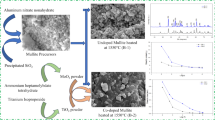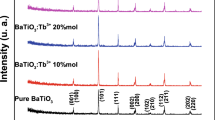Abstract
A sol–gel technique being simple, low cost and application oriented has been used to synthesize doped and un-doped mullite sols. These films have been spin-coated onto copper substrates. Effect of boron doping on the transformation kinetics of mullite was studied by preparing two sols with ratio Al/Si/B = 3/1/0 and Al/Si/B = 3/1/0.5. Surface morphology of thermally stable films showed uniformity in doped and un-doped samples. X-ray diffractometer results revealed orthorhombic mullite formation from both sols at a temperature of 500 °C for un-doped and at 350 °C for doped mullite films. Small crystallite size ~11 nm and low dielectric value ~5.84 (at 3 MHz) were observed in boron-doped films. Un-doped mullite films also showed relatively low dielectric constant, ~6.36, as compared to the previously reported values. The stoichiometry of films was confirmed by EDX and spark source mass spectrometry.









Similar content being viewed by others
References
Wenyan L, Sudipta S, Megan E, Ramsdell J, Scammon K (2003) Physical and optical properties of sol-gel nano-silver doped silica film on glass substrate as a function of heat-treatment temperature. J App Phy 93:9553–9561
Riaz S, Naseem S, Xu YB (2011) Room temperature ferromagnetism in solgel deposited un-doped ZnO –lms. J Sol-Gel Sci Tech 59:584–590
Viswabaskaran V, Gnanam FD, Balasubramanian M (2004) Mullite from clay–reactive alumina for insulating substrate application. App Clay Sci 25:29–35
Liu JG, Wilcox DL Sr (1995) Factors influencing the formation of hollow ceramic microspheres by water extraction of colloidal droplets. J Mater Res 10:84–94
Griesser KJ, Beran A, Voll D, Schneider H (2008) Boromullite, Al9BSi2O19, a new mineral from granulite-facies metapelites, Mount Stafford, central Australia: a natural analogue of a synthetic “boron-mullite”. Miner Petrol 92:309–320
Song F (2011) Needle-like mullite ceramic prepared by sol-gel process. Adv Mat Res 233:2640–2643
Hong SH, Messing LG (1997) Mullite transformation kinetics in P2O5, TiO2 and B2O3-doped aluminosilicate gels. J Am Ceram Soc 80(6):1551–1559
Roy J, Bandyopadhyay N, Das S, Maitra S (2010) Effect of synthetic Fe2O3 on the properties of mullite ceramics derived from Di-phasic Al2O3–SiO2 Gel. J Aust Ceram Soc 46(1):15–22
Zhang G, Fu Z, Wang Y, Wang H, Wang W, Zhang J, Lee SW, Niihara K (2010) Boron-doped mullite derived from single-phase gels. J Euro Ceram Soc 30:2435–2441
Jayasankar M, Anilkumar GM, Smith GM, Mukundan P, Madhusoodana CD, Warrier KGK (2011) Low temperature needle like mullite grain formation in sol–gel precursors coated on SiC porous substrates. Thin Solid Films 519(22):7672–7676
Riaz S, Shamaila S, Khan B, Naseem S (2008) Lower temperature formation of alumina thin films through sol-gel route. Surf Rev Lett 15:681–688
Kaya C, Gu X, Dawery IA, Butler EG (2002) Microstructural development of woven mullite fibre-reinforced mullite ceramic matrix composites by infiltration processing. Sci Tech Adv Mat 3:35–44
Deng Q, Mauritz KA, Moore RB (1995) Novel [ionomer]/[organic-inorganic phase] hybrid materials. Am Chem Soc Polym Prepr 36(1):433–441
Vázquez SB, Puchol RQ, Gasga JR (1999) Structural and chemical analysis of micro-sized particles found in aluminous electrical porcelains. Microsc Microanal 5:247–253
Hong SH, Messing GL (1999) Anisotropic grain growth in boria-doped diphasic mullite gels. J Eur Ceram Soc 19:521–526
Hildmann BO, Schneider H, Schmiicker M (1996) High temperature behavior of polycrystalline aluminosilicate fibers with mullite bulk composition. II. Kinetics of mullite formation. J Eur Ceram Soc 16:287–292
Belhouchet H, Garnier V (2011) characterization of mullite-zirconia composites prepared from various starting alumina phases. Verres Ceramiques Compos 1(2):16–24
Sikalidis C (2011) Advances in ceramics-characterization, raw materials, processing, properties, degradation and healing. InTech, Rijeka, Croatia
Aksay IA, Dabbs DM, Sarikaya M (1991) Mullite for structural, electronic, and optical applications. J Am Ceram Soc 74(10):2343–2358
Holm JL, Kleppa OJ (1996) The thermodynamic properties of the aluminum silicates. Am Mineralogist 51:1608–1627
Panneerselvam M, Rao K (2003) Novel microwave method for the synthesis and sintering of mullite from kaolinite. J Chem Mater 15:2247–2252
Osawa Carla C, Celso AB (2005) Mullite formation from mixtures of alumina and silica sols: mechanism and pH effect. J Braz Chem Soc 16(2):251–258
Sundaresan S, Aksay IA (1991) Mullitization of diphasic aluminosilicate gels. J Am Ceram Soc 74:2388–2392
Tang CC, Emeissfah A, Zhang J, Chen DF (2006) Morphology- and composition-controlled synthesis of aluminium borate nanowires without catalysts. Nanotechnology 17:2362–2368
Hong SH, Cermignani W, Messing GL (1996) Anisotropic grain growth in seeded and B2O3-doped diphasic mullite. J Eur Ceram Soc 16:133–141
Klug HP, Alexander LE (1974) X-ray diffraction procedures for polycrystalline and amorphous materials. Wiley, New York
Riaz S, Naseem S (2007) Effect of reaction temperature and time on the structural properties of Cu(In, Ga)Se2 thin films deposited by sequential elemental layer technique. J Mater Sci Tech 23(04):499–503
Cernansky M (2000) Extrapolation method of the elimination of instrumental broadening of diffraction lines. Mater Struct 7:3–5
Acknowledgments
The authors would like to offer their thanks to Advanced Photonic Science Institute, University Technology Malaysia and Centre of Excellence in Solid State Physics, Punjab University, for effort in the research progress.
Author information
Authors and Affiliations
Corresponding author
Rights and permissions
About this article
Cite this article
Islam, S., Riaz, S., Rahman, R.A. et al. Structural and dielectric properties of boron-doped and un-doped mullite thin films. J Sol-Gel Sci Technol 74, 368–377 (2015). https://doi.org/10.1007/s10971-014-3475-5
Received:
Accepted:
Published:
Issue Date:
DOI: https://doi.org/10.1007/s10971-014-3475-5




